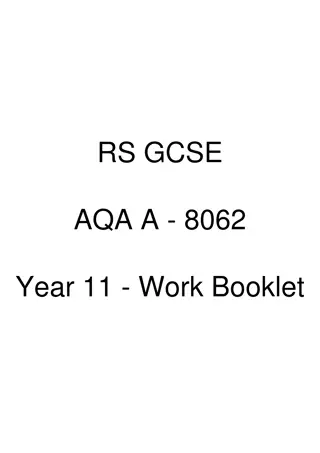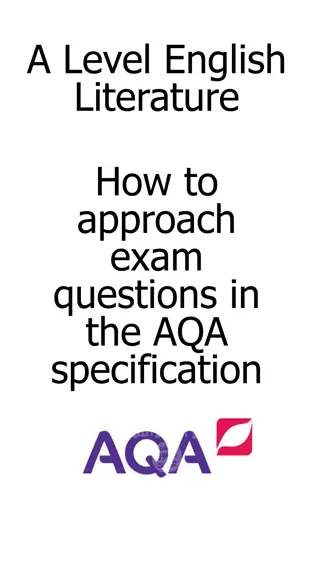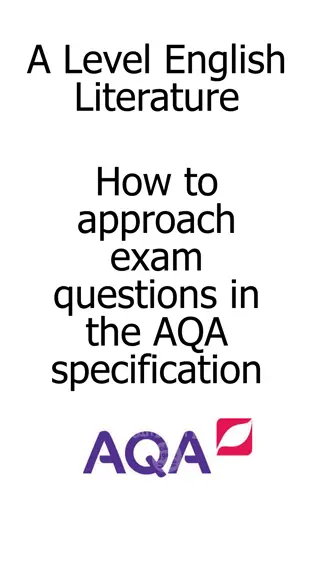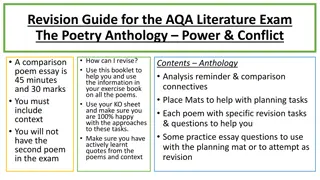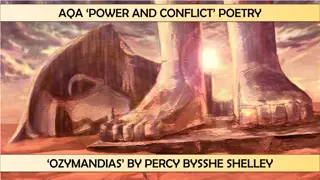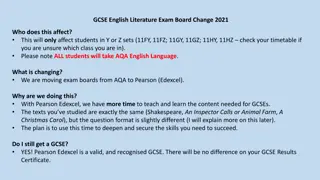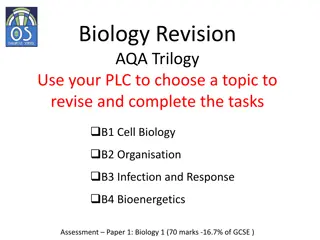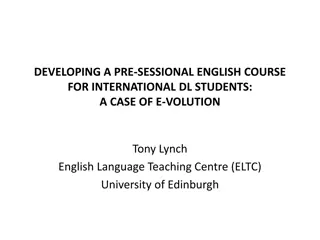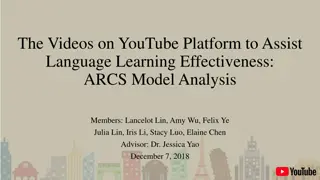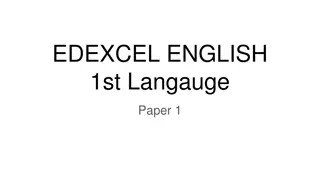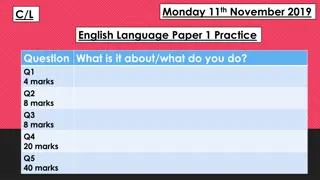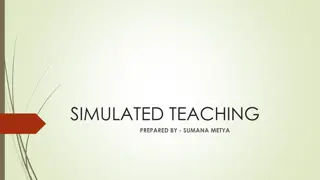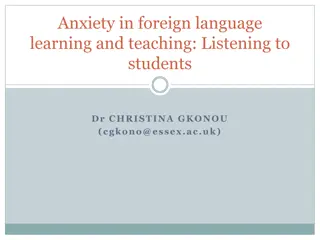Enhancing Teaching Strategies for AQA English Language Paper 2, Section A
Explore strategies to alleviate student anxiety regarding AQA English Language Paper 2, Section A. Learn how to employ effective perspective analysis, engage with 19th-century texts, and promote diverse reading experiences. Discover the importance of writers' viewpoints and how to teach perspectives to foster empathy, tolerance, and critical thinking skills.
Download Presentation

Please find below an Image/Link to download the presentation.
The content on the website is provided AS IS for your information and personal use only. It may not be sold, licensed, or shared on other websites without obtaining consent from the author. Download presentation by click this link. If you encounter any issues during the download, it is possible that the publisher has removed the file from their server.
E N D
Presentation Transcript
AQA English Language Paper 2, Section A - - - - - What makes students anxious about the paper? What can we do to rectify this? Where do we begin? What does perspective actually mean? What does the paper help us to DO as teachers? How can one approach each question? Stuart Pryke @SPryke2
What makes students anxious about the paper? Time Two sources means greater use of reading time. Model with students how to use that time. Offer explicit instructions. (Eg. Read texts twice) Expose students to a variety of 19th century texts. Short stories are successful. Navigating the complexities of a 19th century text. Encourage comparison throughout KS3 through spacing, interleaving and sequencing. Comparison element Non-fiction element Non-fiction element through the literature texts?
19th century texts Key Stage 3 is not a place for GCSE content. Does this mean we have to bombard our students with 19th century texts? Put simply, no. Priorities: - - Ensuring our students are strong readers Ensuring we are focusing on an enjoyment of reading Explicit vocabulary instruction Ensure we are giving students the opportunity to be diverse readers - -
How do I start? What is the paper called? Writers viewpoints and perspectives What can we learn and use from this? From this, students can begin to appreciate that writers write for a reason. It allows us to explore the subtleties and complexities of fiction vs non-fiction. There is intent behind a piece of writing. Exploring perspective will be useful for language and literature. Understanding perspectives allows us to view and interpret texts through a different lens.
How do I start? Writers viewpoints and perspectives 1. In your own words write a definition: 2. Use the term correctly in a sentence: 3. Create a question where the keyword is the answer: KEY WORD: perspective A particular attitude towards or way of regarding something; a point of view. 6. Are all perspectives important? 4. What other words are connected to the key word? 5. Transform the word into a small image and explain your thought process behind your sketch.
Why is perspective important? Teaching perspective is important because: - it allows us to build tolerance and empathy. - students can seek out differing opinions and accounts of events. - it allows us to see beyond the limits of our world and experience something new. - it challenges us. The exam board may only present us with different perspectives of a surf board but the world will present us with different perspectives on life.
Paper 2, Section A Question 1
AQA English Language Paper 2, Question 1 - The aim here is for students to achieve 100%. It s easy to make silly mistakes on this question if not taught properly. - Ask students to underline the lines they need to focus on and the identify those lines in the extract. - Students can place a small dot next to the statement they think is the correct. Double check and then commit Idea from Rebecca Foster - No more than five minutes. Students should use time at the start of the exam to read the text and the statements slowly and carefully. Remind students that the statements are ordered chronologically to match the text. Examiners also reported too many cases of students selecting more than four statements as true, which is a counterproductive approach.
AQA English Language Paper 2, Question 1 - The aim here is for students to achieve 100%. It s easy to make silly mistakes on this question if not taught properly. - Ask students to underline the lines they need to focus on and the identify those lines in the extract. - Students can place a small dot next to the statement they think is the correct. Double check and then commit Idea from Rebecca Foster - No more than five minutes. Students should use time at the start of the exam to read the text and the statements slowly and carefully. Remind students that the statements are ordered chronologically to match the text. Examiners also reported too many cases of students selecting more than four statements as true, which is a counterproductive approach.
But now a knocking at the door was heard, and such a rush immediately ensued that she with laughing face and plundered dress was borne towards it the centre of a flushed and boisterous group, just in time to greet the father, who came home attended by a man laden with Christmas toys and presents. Then the shouting and the struggling, and the onslaught that was made on the defenceless porter! The scaling him with chairs for ladders to dive into his pockets, despoil him of brown-paper parcels, hold on tight by his cravat, hug him round his neck, pommel his back, and kick his legs in irrepressible affection! The shouts of wonder and delight with which the development of every package was received! The terrible announcement that the baby had been taken in the act of putting a doll s frying-pan into his mouth, and was more than suspected of having swallowed a fictitious turkey, glued on a wooden platter! The immense relief of finding this a false alarm! The joy, and gratitude, and ecstasy! They are all indescribable alike. It is enough that by degrees the children and their emotions got out of the parlour, and by one stair at a time, up to the top of the house; where they went to bed, and so subsided. Pick the FOUR statements below which a are true: A The porter is carrying brown paper parcels. B The children cannot reach into the porter s pockets. C There are shouts of wonder and delight from the children. D The children refuse to go to bed because they are so excited. E Scrooge is not interested by what he is seeing. And now Scrooge looked on more attentively than ever, when the master of the house, having his daughter leaning fondly on him, sat down with her and her mother at his own fireside; and when he thought that such another creature, quite as graceful and as full of promise, might have called him father, and been a spring-time in the haggard winter of his life, his sight grew very dim indeed. F The daughter leans fondly on her father. G mother/daughter relationship. Scrooge is happy to witness this Belle, said the husband, turning to his wife with a smile, I saw an old friend of yours this afternoon. Who was it? H Scrooge is taken to see Belle s children and her husband. Guess!
Paper 2, Section A Question 2
AQA English Language Paper 2, Question 2 The summary question: Potential pitfalls: - Students repeat everything the sources say without making any inferences. Statement on the focus of the question Quotation from the source Multiple inferences Link This might insinuate This suggests Could be similarities or differences. This implies Complete the scan test !
Question 2: What makes a Band Two answer? The student needs to think of something else to add to extend this response. It is too brief and so the student is not demonstrating they truly know how to infer. An inference has been made here. The student has said the driver drives very closely and at speed which suggests they are acting dangerously. This is a valid inference but needs to be improved. In Source A, the drivers go too fast. They drive very closely and at speed, which is dangerous behaviour. In Source B, there are drivers who like chasing other people on their bikes, which is very similar to Source A, as it says love to share your handle-bars and wheels, passing so close. This shows they think it is fun to scare them. The similarity is that they both behave dangerously towards cyclists as the drivers in Source A don t care if they hurt someone and the drivers in Source B just think it is for fun. The student makes an attempt to discuss the similarities between the two sources. The similarities are quite obvious which is why this answer has not been awarded higher marks. They do not demonstrate that this student has a full understanding of the two texts. Another brief attempt at inference is made here. Once again, however, it is very brief. There is limited evidence the student here can infer and so the examiner cannot award this answer higher marks.
Question 2: What makes a Band Four answer? Another inference. The student has come to a conclusion about the drivers in Source B based on the quotation passing so close . Perceptive inferences made here. Notice how the answer uses quotations but does not analyse any language. The student has made a prediction about the driver based on the source. The driver in Source A who decided to overtake shows behaviour which is irresponsible but rational. He makes an assessment of the risk in passing very closely and at speed and does not intend any harm, although he knows that the odds are stacked in his favour, cocooned as he is in his car where he will not get hurt. On the other hand, the drivers in Source B are intentionally targeting cyclists by passing so close, which suggests behaviour which is equally irresponsible, as they too know they are protected by their relative size to the bicycle, and are unlikely to get hurt, but their behaviour is irrational and immoral too because it is planned. The motivation of the cabmen who are chasing the lady, and targeting the female writer, suggests perhaps a particular hostility towards women who ride bicycles. The student has stayed focused on the question by identifying some perceptive similarities between the behaviour of the drivers in both sources. A final inference. Notice how this answer is dominated by points the student has inferred. They clearly know the requirements of the question.
Paper 2, Section A Question 3
AQA English Language Paper 2, Question 3 - Students should identify the big ideas in the extract. This will then help them select the best quotations to include as well as what to write about them. Examiners Insights Report (2019): - Model your thought processes. Which words would you pick and why? 9 - Explain why you wouldn t pick a certain word. - Encourage multiple interpretation.
AQA English Language Paper 2, Question 3 Example from Paper 1 (Mr Fisher) but the principle is exactly the same. Chris Curtis How To Teach English Word: golden Word: Reason 1 Implies they were extremely precious Reason 1 Books were golden Reason 2 Something to be treasured Reason 2 Also, check out Andy s (@_codexterous) video on English Language, Paper 1 What word could be used instead? Reason 3 Presents their value in financial terms Reason 3 - Word: Word: Reason 1 Reason 1 Reason 2 Reason 2 Reason 3 - Reason 3 -
Paper 2, Question 3 What is the role of the reader? - - - This makes the reader think Who is this elusive reader? Do we need to show an awareness of the intended audience? Students tend to assign readers a rather passive role. They think , but rarely anything else. - This might force one to criticise - At this moment, we are forced to re- evaluate - Perhaps we should reflect on our previous judgement of XYZ here because - The use of XYZ causes us to question - One could theorise here that Give the reader something to do! What makes a perceptive analysis : - Identifying the writer s big ideas Answers where students introduce their own, unique voice -
Paper 2, Question 3 What can we learn from the mark scheme? - Sentence forms can be difficult to write about. - Subject terminology is important but talking about the effect is even more so? - Single word analysis and multiple interpretations are a winner! - Examiner top tip! If you can ask why? after you have read a point, it s not yet perceptive enough. - Break away from set structures (PEE, PEEL, PETAL) - Redraft. What does excellence look like?
Paper 2, Section A Question 4 The synoptic question!
AQA English Language Paper 2, Question 4 Comparison of perspectives What is the writer thinking, feeling, imagining and experiencing? What methods do they use to present those thoughts, feelings, imaginings and experiences? Talk about comparison and what that entails. Tell students you re completing the scan test for words like similarly and on the other hand . Opening statement that comments on a key similarity and difference between the two sources. Does the perspective change? This provides an anchor for a student s answer. A B Similarly, Writer B s experience of leaves him imagining that , evident through his use of Writer A clearly feels , explaining that . Her use of primarily shows Quotation 1 Quotation 1 Quotation 2 Quotation 2 On the other hand, Writer B s experience remains largely the same. He believes , implying Writer A s feeling of begins to change, however, when Quotation 3 Quotation 3
AQA English Language Paper 2, Question 4 Comparison of perspectives What is the writer thinking, feeling, imagining and experiencing? What methods do they use to present those thoughts, feelings, imaginings and experiences? Opening statement that comments on a key similarity and difference between the two sources. Does the perspective change? This provides an anchor for a student s answer. Model but make it granular! 1. Teacher completes opening statement. Similarly, Writer B s experience of leaves him imagining that , evident through his use of Writer A clearly feels , explaining that . Her use of primarily shows 2. Student writes their own. 3. Teacher models first lines of opening paragraph. On the other hand, Writer B s experience remains largely the same. He believes , implying Writer A s feeling of begins to change, however, when 4. Student writes their own.
AQA English Language Paper 2, Question 4 Comparison of perspectives What is the writer thinking, feeling, imagining and experiencing? What methods do they use to present those thoughts, feelings, imaginings and experiences? Opening statement that comments on a key similarity and difference between the two sources. Does the perspective change? This provides an anchor for a student s answer. Students expect the perspective to jump out at them and it doesn t. Similarly, Writer B s experience of leaves him imagining that , evident through his use of Writer A clearly feels , explaining that . Her use of primarily shows 1. What is the writer s attitude? 2. How is this attitude presented to us? On the other hand, Writer B s experience remains largely the same. He believes , implying Writer A s feeling of begins to change, however, when 3. Why is it presented in this way?
Developing emotional/perspective literacy The writer feels shocked. Does anyone else hate this word? - - - Lots of students have a deficit of emotional literacy. This means they cannot always fully articulate how they are feeling. If they can t articulate how they are feeling, how can they articulate how someone else is feeling? - - - Utilise emotion wheels to help students be specific with their answers. Useful for literature too! The reader would be shocked at this because Helpful for achieving that perceptive point. Specificity is key! Emotion is not necessarily perspective BUT perspective does not exclude emotion.
AQA English Language Top tips! - Encourage students to use the majority of their reading time. It will help them access the harder paper. - Lots of modelling! Make things granular and model each step of a paragraph rather than a whole paragraph at once. - Teach students why perspective is important. What can we gain from considering perspective. - Model what excellence looks like. Get students to redraft and compare their answers. - Focus on comparison.



















